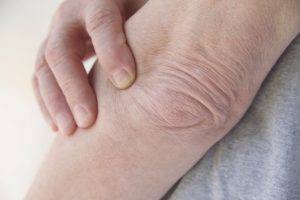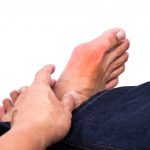 Bursitis and gout both affect the joints and can lead to inflammation and severe pain in the affected joints. Gout impacts the joint more directly than bursitis, which impacts the fluid-filled sacs that surround the joints and eliminate friction. Gout is caused by the formation of uric acid crystals, while bursitis can actually have a variety of causes, which we will go over in greater detail further on.
Bursitis and gout both affect the joints and can lead to inflammation and severe pain in the affected joints. Gout impacts the joint more directly than bursitis, which impacts the fluid-filled sacs that surround the joints and eliminate friction. Gout is caused by the formation of uric acid crystals, while bursitis can actually have a variety of causes, which we will go over in greater detail further on.
Another main difference between gout and bursitis is that bursitis can occur due to overuse of a certain joint, whereas this is not the case in gout. Performing repetitive motions is a key risk factor for bursitis – again, this doesn’t apply to gout.
Advertisement
Here, we will further explore the similarities and differences between bursitis and gout to help you better understand both of these joint conditions.
Can bursitis lead to arthritis? Bursitis and gout connection
Having gout – a type of arthritis – is a known risk factor for bursitis, but the question remains: Can bursitis lead to arthritis? The simple answer is no – although bursitis can be caused by arthritis, it does not lead to it.
Bursitis can be caused by an infection or overuse, but these can be treated, so there is no long term effect. To prevent bursitis, it’s important to avoid your triggers or modify your movements so that inflammation of the bursa doesn’t happen again.
Bursitis vs. gout: U.S. prevalence
 The worldwide prevalence of gout is one to four percent. In the U.S. specifically, 3.9 percent are affected by gout. The authors of the study Global Epidemiology of Gout: Prevalence, Incidences and Risk Factors wrote, “The prevalence of gout in more affluent countries seems to be increasing in recent decades. However, only a few studies give reliable data on secular trends in gout prevalence. The US NHANES study found a significantly higher age-adjusted prevalence (3.9 percent) in 2007–2008 than the estimate in 1988–1994 (2.9 percent). This trend paralleled an observed increase in hyperuricemia.”
The worldwide prevalence of gout is one to four percent. In the U.S. specifically, 3.9 percent are affected by gout. The authors of the study Global Epidemiology of Gout: Prevalence, Incidences and Risk Factors wrote, “The prevalence of gout in more affluent countries seems to be increasing in recent decades. However, only a few studies give reliable data on secular trends in gout prevalence. The US NHANES study found a significantly higher age-adjusted prevalence (3.9 percent) in 2007–2008 than the estimate in 1988–1994 (2.9 percent). This trend paralleled an observed increase in hyperuricemia.”
Men are at a higher risk of developing gout compared to women, especially those over the age of 40. Individuals who have undergone an organ transplant are at a heightened risk for gout as well.
Bursitis accounts for 0.4 percent of primary care visits in the U.S. It is commonly seen in athletes, with incidence rates as high as 10 percent. Bursitis affects men more than women, especially those who work in construction or who are frequently kneeling.
Difference between gout and bursitis: Signs and symptoms
Typical symptoms of bursitis include pain, tenderness even without motion, swelling, and loss of movement. If bursitis is caused by an infection, additional symptoms – such as fever, redness of the area, and the affected area feeling hot to touch – may be present. It’s important to note that symptoms also depend on the location of bursitis. Here are some additional symptoms experienced in specific locations in the body.
Hip: Pain may occur at the side of the hip and radiate to the thigh. The hip may be painful to touch. Walking, climbing stairs, and lying on your side becomes difficult.
Knee: Pain with movement is rare, unless the joint is significantly flexed.
Elbow: Swelling. Tenderness may occur if infection is present.
Heel: This type of bursitis is often associated with runners and is caused by overuse.
Common signs and symptoms of gout are:
- Intense joint pain, especially in the large toe
- Lingering discomfort even after the intense pain has subsided
- Inflammation and redness of the affected joint
- Limited range of motion
If a fever develops or the joint feels hot to touch, see your doctor right away. Gout can be successfully managed as long as your doctor is aware of your condition.
Comparing bursitis and gout causes
 Bursitis is a common cause of painful hips, knees, and elbows, but it can be managed with nonsurgical treatments. Bursitis occurs when the bursa – a small, fluid-filled sac that acts as a cushion and lubricator for our bones, muscles, and tendons around our joints – becomes irritated or infected, causing pain through movement. If bursitis is caused by an infection, then medical treatment is required. But if no infection is found, then medical attention can help prevent the condition from worsening.
Bursitis is a common cause of painful hips, knees, and elbows, but it can be managed with nonsurgical treatments. Bursitis occurs when the bursa – a small, fluid-filled sac that acts as a cushion and lubricator for our bones, muscles, and tendons around our joints – becomes irritated or infected, causing pain through movement. If bursitis is caused by an infection, then medical treatment is required. But if no infection is found, then medical attention can help prevent the condition from worsening.
A person has bursitis when inflammation of the bursa occurs, causing pain when moving.
Bursitis can affect any joint, including the hip, knees, shoulder, elbow, buttocks, and thigh.
The common causes of bursitis are injury, infection, or a pre-existing condition in which crystals form in the bursa.
Gout is a result of crystallized uric acid, which occurs when a person has high levels of uric acid in their blood. Uric acid results from the breakdown of purines found in some foods like red meat and alcohol.
Normally, uric acid passes through our systems and is released through our urine, but with excessively high levels, the uric acid can build up and crystallize in joints and surrounding tissues, causing discomforting symptoms.
Difference between bursitis and gout: Risk factors and complications
Risk factors for gout include eating a diet high in uric acid-promoting purines, being overweight or obese, having an untreated medical condition like hypertension, taking certain medications, having a family history of gout, being male over the age of 40, and recovering from a recent surgery or trauma.
Gout complications include reoccurring gout (the patient will experience frequent flares that can cause erosion and damage to the bones), advanced gout (nodules develop beneath the skin – these are known as tophi and can become tender and painful during gout attacks), and kidney stones, which can cause damage to the kidneys if they reoccur.
Risk factors for bursitis include being of older age, working in certain occupations such as tile laying, painting, or playing a musical instrument. Having other medical conditions, such as rheumatoid arthritis, gout, and diabetes, increases the risk of bursitis as well.
Bursitis itself is an inflammation of the bursa, so when your bursa is okay you won’t experience or develop any bursitis-related symptoms. One main complication associated with bursitis is bunion. This is the swelling of the first joint on the big toe, and it gets pretty painful. If you develop bunions you should speak to your doctor about the possibility of surgical treatment.
Diagnosis and treatment options for gout and bursitis
 Unless an infection is present, bursitis can be well managed through self-care. It’s important to remember the acronym PRICEM when treating bursitis at home.
Unless an infection is present, bursitis can be well managed through self-care. It’s important to remember the acronym PRICEM when treating bursitis at home.
Protection – Protect the area from future injuries by wearing padding.
Rest – Limit the use of the joint and let it rest.
Ice – Apply ice packs a few times a day, but not directly onto your skin.
Compression – Wear compression bandaging to limit blood flow to the area as it contributes to swelling.
Elevation – Keep the joint elevated if possible to prevent blood from pooling in the area.
Medication – Take anti-inflammatory medication or antibiotics as instructed by your doctor.
In the rare instance, surgery may be recommended to drain the bursa in order to alleviate the inflammation.
Other treatment options include physical therapy, corticosteroid injections, and assistive devices like a cane.
Some preventative means for bursitis include protecting the joints from injury, either by wearing protective clothing or by modifying or avoiding certain activities. Take a moment to rest if you are performing repetitive tasks, always warm up prior to exercise, and build strong muscles to protect your joints.
Advertisement
Other preventative measures include maintaining a healthy weight, using kneeling pads, lifting objects correctly, wheeling heavy loads, avoiding sitting for long periods of time, and exercising regularly.
Gout can also be treated with medications, including NSAIDs and other pain relievers. Some medications can be prescribed to prevent gout complications, including medications to block uric acid and medications to improve uric acid removal.
Lifestyle changes and home remedies can also be implemented for better gout management. For example, limiting alcoholic and sugary beverages, reducing your intake of high purine foods (like red meat, organ meat, and seafood), exercising regularly, and maintaining a healthy weight.
